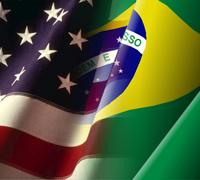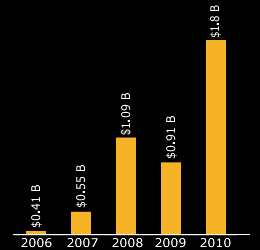 With over 140 million consumers, a growing middle class, and almost unlimited infrastructure needs, Russia remains one of the most promising markets for U.S. exporters. Russia is the world’s 11th largest economy and has the highest per capita GDP ($15,900) of the BRIC countries. It is an upper middle income country, with a highly educated workforce and sophisticated, discerning consumers. Russia’s economy has begun to recover from the economic crisis that started in 2008, with GDP growth at 4.0% for 2010.
With over 140 million consumers, a growing middle class, and almost unlimited infrastructure needs, Russia remains one of the most promising markets for U.S. exporters. Russia is the world’s 11th largest economy and has the highest per capita GDP ($15,900) of the BRIC countries. It is an upper middle income country, with a highly educated workforce and sophisticated, discerning consumers. Russia’s economy has begun to recover from the economic crisis that started in 2008, with GDP growth at 4.0% for 2010.
This growth was slightly less than anticipated due to drought and wildfires, which disrupted agriculture, commerce and industry. Economists forecast real GDP growth of 4.3% in 2011. Russia was the U.S.’s 37th largest export market and the 17th largest exporter to the U.S. in 2010. U.S. exports to Russia were $5.97 billion, a 12% increase from 2009.
Russian exports to the U.S. were $26.5 billion, up 41% from 2009. Russian sources list the country’s leading trade partners as: Netherlands, China, Germany, Italy, Ukraine and Turkey. U.S. accumulated investment in Russia is approximately $21.3 billion. According to Russian data, the U.S. is Russia’s 10th largest foreign investor.










 MBDA National Director Hinson and Shawn Ricks, Senior Advisor to the National Director on Global Affairs began a five-day trip to Brasilia and Sao Paulo, Brazil. This trip will provide an opportunity for MBDA to build relationships with key stakeholder groups essential to reaching its export targets under the National Export Initiative, create greater access to emerging markets for minority business enterprises, and support job creation in the United States.
MBDA National Director Hinson and Shawn Ricks, Senior Advisor to the National Director on Global Affairs began a five-day trip to Brasilia and Sao Paulo, Brazil. This trip will provide an opportunity for MBDA to build relationships with key stakeholder groups essential to reaching its export targets under the National Export Initiative, create greater access to emerging markets for minority business enterprises, and support job creation in the United States. Forming strategic business relationships is a way to enhance the competitive advantage of a minority-owned firms and increase success in securing business that might otherwise go to another supplier. Business relationships take on many forms, from simple contractual relationships to acquisitions. But overall, these relationships are enduring business arrangements falling somewhere on the spectrum between these two extremes.
Forming strategic business relationships is a way to enhance the competitive advantage of a minority-owned firms and increase success in securing business that might otherwise go to another supplier. Business relationships take on many forms, from simple contractual relationships to acquisitions. But overall, these relationships are enduring business arrangements falling somewhere on the spectrum between these two extremes.
 The
The  Vietnam is a true emerging market, offering ground floor and growing opportunities for U.S. exporters and investors. Vietnam’s economic growth rate has been among the highest in the world in recent years, expanding at an average about 7.2 percent per year during the period 2001-2010, while industrial production grew at an average of about 12 percent per year during the same period.
Vietnam is a true emerging market, offering ground floor and growing opportunities for U.S. exporters and investors. Vietnam’s economic growth rate has been among the highest in the world in recent years, expanding at an average about 7.2 percent per year during the period 2001-2010, while industrial production grew at an average of about 12 percent per year during the same period. The long anticipated Korea-U.S. Free Trade Agreement (KORUS-FTA) was implemented on March 15, 2012 becoming our nation’s largest FTA since NAFTA. The agreement has the potential to increase U.S. exports to Korea by approximately USD 10-12 billion, and it will be especially beneficial for U.S. SMEs. In 2009, nearly 18,000 SMEs exported some USD 8.4 billion worth of merchandise to Korea.
The long anticipated Korea-U.S. Free Trade Agreement (KORUS-FTA) was implemented on March 15, 2012 becoming our nation’s largest FTA since NAFTA. The agreement has the potential to increase U.S. exports to Korea by approximately USD 10-12 billion, and it will be especially beneficial for U.S. SMEs. In 2009, nearly 18,000 SMEs exported some USD 8.4 billion worth of merchandise to Korea. The United States-Korea Trade Agreement (KORUS Agreement) enters into effect today, reducing tariffs on almost all U.S. industrial exports to South Korea and making it easier for U.S. exporters to successfully compete in the Korean market.
The United States-Korea Trade Agreement (KORUS Agreement) enters into effect today, reducing tariffs on almost all U.S. industrial exports to South Korea and making it easier for U.S. exporters to successfully compete in the Korean market. With over 140 million consumers, a growing middle class, and almost unlimited infrastructure needs, Russia remains one of the most promising markets for U.S. exporters. Russia is the world’s 11th largest economy and has the highest per capita GDP ($15,900) of the BRIC countries. It is an upper middle income country, with a highly educated workforce and sophisticated, discerning consumers. Russia’s economy has begun to recover from the economic crisis that started in 2008, with GDP growth at 4.0% for 2010.
With over 140 million consumers, a growing middle class, and almost unlimited infrastructure needs, Russia remains one of the most promising markets for U.S. exporters. Russia is the world’s 11th largest economy and has the highest per capita GDP ($15,900) of the BRIC countries. It is an upper middle income country, with a highly educated workforce and sophisticated, discerning consumers. Russia’s economy has begun to recover from the economic crisis that started in 2008, with GDP growth at 4.0% for 2010.

